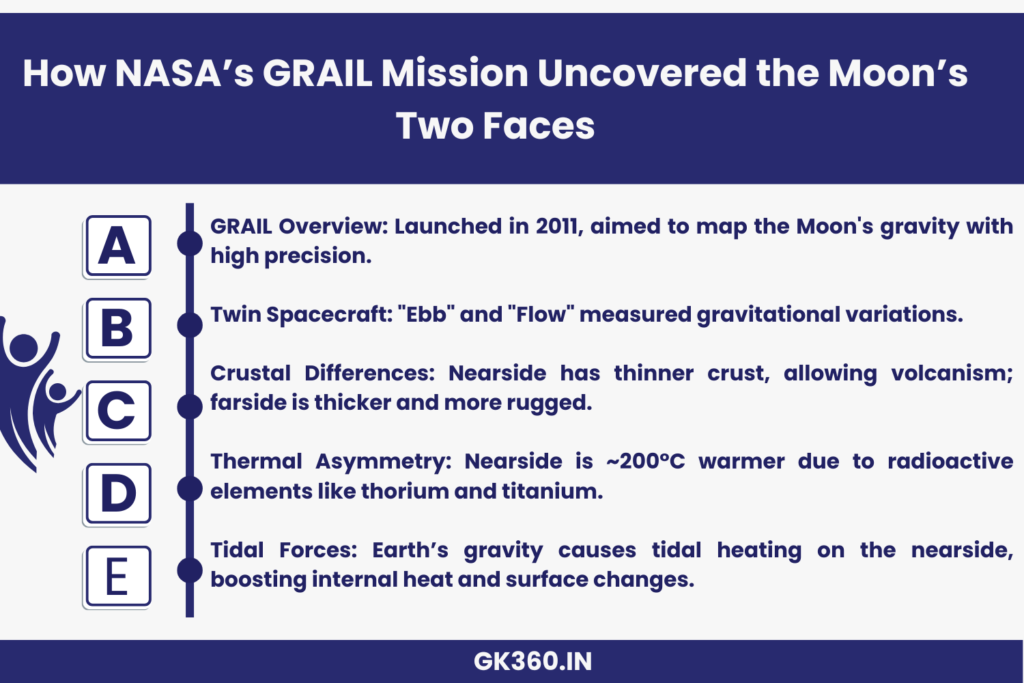NASA GRAIL Mission: Why the Moon Has Two Faces
Introduction: A Moon Mystery Finally Solved
For decades, astronomers and space scientists puzzled over a striking cosmic riddle: why does the Moon’s nearside, which always faces Earth, look so different from its farside? The answer has finally been revealed—thanks to NASA’s Gravity Recovery and Interior Laboratory (GRAIL) mission. This groundbreaking study, using high-resolution gravitational data, shows that internal heat, crustal thickness, and Earth’s own gravitational pull shaped the Moon’s asymmetric evolution.
The findings not only reshape our understanding of the Moon’s internal structure and volcanic history but also have far-reaching implications for planetary science, future lunar missions, and theories of celestial body formation.

Table of Contents
- Introduction
- What Is the GRAIL Mission?
- Key Scientific Discoveries
- Scientific and Practical Significance
- FAQs on NASA’s GRAIL Mission
- Conclusion: Rewriting Lunar History
What Is the GRAIL Mission?
Mission Overview and Objectives
GRAIL, which stands for Gravity Recovery and Interior Laboratory, is a NASA mission launched in 2011 to understand the Moon’s inner composition. Operated by NASA’s Jet Propulsion Laboratory (JPL) and led scientifically by MIT, the mission’s goal was to map the Moon’s gravity field with unprecedented accuracy.
The Ebb and Flow Spacecraft
The mission involved two nearly identical spacecraft, Ebb and Flow, that orbited the Moon in tandem. As they moved over areas with different gravitational strengths, the distance between the probes slightly changed. These tiny variations were used to create the most detailed gravitational map of the Moon ever produced.
Key Scientific Discoveries
Mapping the Moon’s Gravity in Detail
GRAIL’s high-resolution gravity mapping detected minute shifts in mass distribution beneath the Moon’s surface. These measurements exposed subsurface structures and revealed variations in density, rock composition, and internal layering, offering new clues about lunar formation and evolution.
Crust Thickness: Nearside vs. Farside
One of the mission’s most profound findings was the stark contrast in crustal thickness between the Moon’s two hemispheres:
- Nearside: Has a thinner crust, allowing heat and molten rock to reach the surface more easily. This led to massive volcanic eruptions, forming dark, basaltic plains known as maria.
- Farside: Features a much thicker crust, which suppressed volcanic activity. As a result, it is more rugged, heavily cratered, and lacks extensive maria.
Internal Heat and Radioactive Elements
The GRAIL mission also revealed significant thermal asymmetry within the Moon:
- The nearside mantle is ~200°C warmer than the farside.
- This temperature difference stems from a higher concentration of radioactive elements like thorium and titanium on the nearside, which release heat during radioactive decay.
- The additional warmth helped melt subsurface rock, fueling volcanic activity.
Earth’s Tidal Forces on the Moon
Because the Moon is tidally locked—always showing the same face to Earth—our planet exerts continuous gravitational pressure on its nearside. This leads to:
- Tidal flexing: Repeated stretching and compressing of the lunar surface.
- Internal friction and heat: Adds to the temperature disparity, further promoting volcanism on the nearside.
Together, these effects have etched a permanent geological fingerprint on the Moon’s structure.
Scientific and Practical Significance
Resolving a Lunar Mystery
For years, the Moon’s dual personality baffled scientists: a smooth, volcanic nearside versus a rugged, cratered farside. The GRAIL mission confirms that this is no coincidence. The crustal dichotomy, thermal imbalance, and tidal heating all combine to shape the Moon’s distinct hemispheres. It’s not just a matter of perspective—it’s deep-rooted in the Moon’s internal architecture.
Insights into Planetary Formation
These findings reach beyond our Moon. They offer a template for understanding other planetary bodies—including Mars, Mercury, and even exoplanets:
- How internal heat shapes surface geology
- The role of radioactive decay in planetary evolution
- Tidal effects in planet-moon or planet-star systems
By decoding the Moon’s hidden mechanics, GRAIL contributes to astrogeology and planetary science models across the solar system.
Implications for Future Lunar Missions
GRAIL’s data has strategic value for space exploration:
- Landing Site Selection: Identifying areas with thinner crust and thermal gradients is essential for safety and drilling operations.
- Mineral Resource Mapping: Regions rich in thorium and titanium may be targeted for future resource extraction.
- Lunar Bases: Thermally favorable zones offer practical benefits for human habitation and infrastructure stability.
Whether it’s NASA’s Artemis Program or international lunar collaboration, GRAIL has laid the gravitational groundwork.

FAQs on NASA’s GRAIL Mission
- What does GRAIL stand for?
GRAIL stands for Gravity Recovery and Interior Laboratory, a mission designed to map the Moon’s gravitational field and explore its internal structure. - Why are the near and far sides of the Moon so different?
Due to differences in crust thickness, internal heat, and Earth’s tidal pull, the nearside experienced more volcanic activity, while the farside remained cooler and more cratered. - What role do radioactive elements play in the Moon’s geology?
Elements like thorium and titanium decay and release heat, warming the nearside mantle and enabling molten rock to rise and erupt. - How does Earth’s gravity affect the Moon?
Earth’s gravity causes tidal flexing on the nearside, creating frictional heat that intensifies internal warming and geological activity. - How will this discovery help future missions?
GRAIL’s gravity and heat maps help in choosing safe landing zones, targeting mineral-rich areas, and understanding structural risks beneath the lunar surface.
Conclusion: Rewriting Lunar History
Thanks to the GRAIL mission, the Moon is no longer a static, silent satellite. It’s a world shaped by gravitational forces, radioactive heat, and complex internal dynamics. The stark differences between its nearside and farside are now understood through the lens of crustal thickness, mantle temperature, and tidal flexing.
This discovery is more than scientific curiosity—it’s a foundation for lunar colonization, mineral extraction, and planetary modeling. GRAIL has helped crack one of space science’s most compelling riddles, opening the door to deeper cosmic understanding.
Key Takeaways Table
| Aspect | Details |
| Mission Purpose | To map the Moon’s gravitational field in high detail using twin spacecraft. |
| Key Discovery | Nearside and farside differ due to crust thickness, heat, and Earth’s tidal forces. |
| Crustal Insight | Nearside is thinner with extensive volcanism; farside is thicker and rugged. |
| Thermal Findings | Nearside is 200°C hotter due to radioactive decay (thorium, titanium). |
| Role of Earth’s Gravity | Causes tidal flexing and heating, enhancing nearside volcanic activity. |
| Scientific Relevance | Offers new understanding of lunar and planetary geology. |
| Application for Missions | Informs landing site selection, resource extraction, and lunar base planning. |





